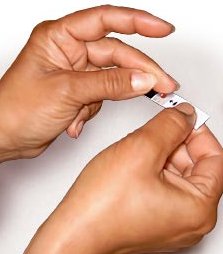Monitoring Diabetes

Monitoring diabetes is extremely important.
The key word for diabetes care is are balancing, beacause the desirable outcome is a regular and good lifestyle.
You have to learn how to balance your blood sugar levels.
Good balancing requires good test results which provides information for making the right decisions and actions.

Doctors usually prefer the blood test for several reasons:
- Blood tests give immediate and precise results which allow you to treat your body in the most efficient way.
- You can do self testing of blood glucose, and even more than one in a day.
That can give you a precise estimation of the effects of the food you eat or the exercises you do on your blood sugar level.
You can learn from those self tests about the best ways to balance your blood sugar levels and the best ways to cope with diabetes. - The urine test can point on high levels of blood sugar only when the levels are already very high.
It can be misleading because the amount of sugar in the urine may not reflect the current level of sugar in the blood, while the blood test is immediate.
If you want a good independent control of your diabetes, my best recommended method is to do self testing blood glucose level.
The self testing requires only a little drop of blood which you can obtain by a small prick in the finger.
You can find it nearly painless. You put the drop of blood on the special test strip pad of your diabetes self testing kit, and follow the instructions included with your personal sensor or meter.
GoldenEraMart
is an online store catering to the ailing and infirm. |
Your diabetes educator or physician may prescribe some tests for you several times a day. It could be before meals, it could be 2 hours after meals, it could be at bedtime, or in the early morning hours (between 3 a.m. to 5 a.m. because blood sugar levels increases at that hours). |
For all of those who don't know or remember what Ketones are, you can read about it in the diagnosis chapter.
There is another way to monitor your average blood sugar levels in the past 2-3 months. It is the Glycosylated Hemoglobin, or HbA1C test. Hemoglobin is a protein in the red blood cells. When the glucose is bound to the hemoglobin it becomes "Glycosylated".
We can track and monitor the average blood glucose levels over the preceding 3 months which is the lifetime of red blood cells with their hemoglobin.
If the average level of the Glycosylated hemoglobin in those 3 months is high, it means that your blood sugar level is high too.
|
Return from Monitoring to Diabetes Guide |